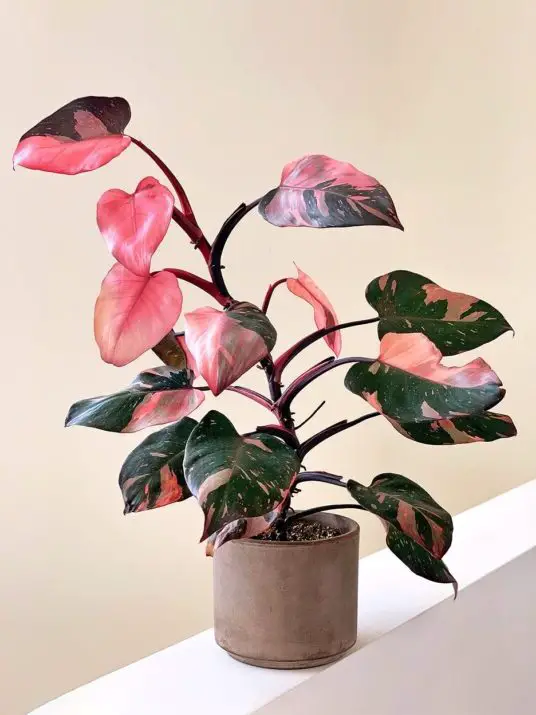Pink princess philodendron plants have become the latest obsession among plant enthusiasts, captivating their hearts with their striking pink variegated leaves. But have you ever wondered why these stunning houseplants come with a hefty price tag? Well, the answer lies in their rarity and the meticulous process of propagation. The demand for pink princess philodendron has surged, making them a prized possession for collectors and plant lovers alike.
In this article, we will delve into the factors that contribute to the high cost of these enchanting plants, so you can understand why pink princess philodendron is so expensive.
The High Cost Of Pink Princess Philodendron: Exploring The Expensive Phenomenon
Pink Princess Philodendron, with its stunning pink and green foliage, has become one of the most sought-after houseplants among plant enthusiasts and collectors.
However, its rarity and high demand have led to exorbitant prices in the market. In this article, we will explore the factors that contribute to the expensive nature of Pink Princess Philodendron, shedding light on their limited availability, unique characteristics, and propagation challenges.
The Rarity Factor
One of the primary reasons why Pink Princess Philodendron comes with a hefty price tag is its rarity. This plant is native to the tropical rainforests of South America, specifically found in regions of Colombia and Ecuador. The limited natural habitat of Pink Princess Philodendron makes it difficult to find in the wild, resulting in a scarcity of this beautiful plant.
Furthermore, due to deforestation and illegal plant collection, the number of Pink Princess Philodendron in the wild has significantly decreased over the years. These factors contribute to the rarity of the plant, making it a coveted find for plant enthusiasts and collectors alike.
Read More: About Aquaponics Vs. Polyaquaculture
Unique Characteristics
Pink Princess Philodendron owes its name to its distinctive pink variegation, which sets it apart from other Philodendron varieties. The combination of deep green foliage with splashes of pink creates an eye-catching display, making it a desirable addition to any indoor space.
The variegation pattern of Pink Princess Philodendron is unpredictable, adding to its allure. Each leaf is unique, showcasing different shades of pink and green, making every plant an individual work of art. The unpredictability and beauty of the variegation contribute to the plant’s desirability, driving up its price in the market.
Propagation Challenges
Unlike many other houseplants, propagating Pink Princess Philodendron can be a complex and time-consuming process. This plant cannot be reliably propagated through traditional methods such as stem cuttings. Instead, it is usually propagated through tissue culture, a method that requires specialized equipment and expertise.
Tissue culture involves taking small sections of the plant’s tissue and placing them in a sterile nutrient medium, where they grow into new plants. This process requires a controlled environment and precise conditions to be successful. As a result, the production of Pink Princess Philodendron through tissue culture is labor-intensive and expensive, contributing to its high price.
Market Demand and Trends
The popularity of houseplants, in general, has surged in recent years, with people turning to plants as a way to enhance their living spaces and reconnect with nature. Pink Princess Philodendron, with its unique and vibrant foliage, has become a symbol of the current plant frenzy.
Social media platforms have played a significant role in fueling the demand for Pink Princess Philodendron. Instagram and Pinterest, in particular, are flooded with images of this stunning plant, captivating plant lovers with its beauty. The desire to own and showcase Pink Princess Philodendron on social media has driven up its demand, leading to inflated prices in the market.
Supply and Availability
The limited supply and low availability of Pink Princess Philodendron contribute to its high price. Due to the challenges associated with propagation, nurseries and growers can only produce a limited number of plants at a time. Additionally, the time-consuming nature of tissue culture means that it takes a significant amount of time to raise a substantial quantity of plants for sale.
As a result, the limited supply of Pink Princess Philodendron cannot meet the growing demand. This scarcity drives up the price further, as collectors and enthusiasts are willing to pay a premium to add this rare beauty to their plant collections.
The Collectors’ Market
The world of plant collecting has gained immense popularity, with collectors willing to invest large sums to acquire rare and unique plants. Pink Princess Philodendron has become a highly sought-after item for collectors, driving up its price in the collectors’ market.
In the world of plant collecting, rarity and uniqueness hold great value. Pink Princess Philodendron, with its limited supply, unpredictable variegation, and stunning appearance, checks all the boxes for collectors looking to expand their collections with prized specimens. The collectors’ market creates competition and drives prices to unprecedented levels.
Pink Princess Philodendron’s expensive price tag can be attributed to its rarity, unique characteristics, propagation challenges, high demand, limited supply, and the collectors’ market. These factors combine to make it a prized plant for enthusiasts and collectors alike, resulting in high prices in the market.
If you’re lucky enough to get your hands on a Pink Princess Philodendron, it is a testament to your dedication and passion for plants. The vibrant foliage and the sense of accomplishment that comes with owning such a sought-after plant make the investment worth it for many.
Read More: About How To Keep Grass Out Of Wildflowers?
Frequently Asked Questions (FAQs)
Pink princess philodendrons are rare because they are a chimera, meaning they have a mix of genetic traits resulting in their unique appearance. This rarity makes them highly sought after by plant enthusiasts.
Pink princess philodendrons require specific care and environmental conditions to thrive. They prefer bright indirect light, high humidity, and well-draining soil. With proper care, they can be grown successfully, but they may require more attention compared to other houseplants.
Yes, pink princess philodendrons can be propagated through stem cuttings. However, it is important to note that variegated plants like the pink princess may produce non-variegated offspring. Propagation may not always guarantee the same unique patterns and colors, so purchasing an established plant may be preferred by collectors.
The price of pink princess philodendrons can vary based on factors such as plant size, condition, rarity, and seller’s location. Larger, well-established plants with vibrant variegation patterns will generally command a higher price than smaller or less impressive specimens.
Pink princess philodendrons can be found for sale at specialized plant nurseries, online plant marketplaces, or through private sellers. It is advisable to research reputable sellers and read reviews before making a purchase.
Yes, there are alternative plants that have a similar appearance to pink princess philodendrons. Some options include philodendron erubescens ‘Black Cardinal’, philodendron ‘Birkin’, or other variegated philodendron varieties. These alternatives may be more readily available and relatively more affordable.
Yes, pink princess philodendrons require specific care. They thrive in bright indirect light, high humidity, and well-draining soil. It is best to keep them away from direct sunlight, as it may cause leaf burn. Regularly wiping their large leaves with a damp cloth can also help maintain their appearance.
Final Thoughts
Pink princess philodendron is highly sought after for its stunning foliage, characterized by deep burgundy leaves adorned with vibrant pink speckles and veins. This unique and beautiful appearance is the primary factor driving its high price in the market. The scarcity of pink princess philodendron further adds to its demand and value. Cultivating this plant is challenging and time-consuming, requiring specific conditions and expertise. Additionally, the propagation process is slow, making it difficult to meet the increasing demand.
As a result, the limited supply and high demand create an exclusive and expensive market for pink princess philodendron. Their rarity and aesthetic appeal make them highly coveted among plant enthusiasts and collectors, justifying their elevated prices. So, why are pink princess philodendron so expensive? It’s a combination of their unique beauty, limited availability, and the effort required to grow them.
Auto Amazon Links: No products found.
Perfect Plants Christmas Tree Saver 8oz. | Easy Use Xmas Tree Preserver Food | Have Healthy Green Christmas Trees All Holiday Season
$9.97 (as of December 3, 2025 00:36 GMT +00:00 - More info- Product prices and availability are accurate as of the date/time indicated and are subject to change. Any price and availability information displayed on [relevant Amazon Site(s), as applicable] at the time of purchase will apply to the purchase of this product.
Kaiedos Christmas Tree Watering Funnel - 39 Inch Funnel, Reusable Design, Makes Watering Your Live Tree a Snap!
$14.99 (as of December 3, 2025 00:36 GMT +00:00 - More info- Product prices and availability are accurate as of the date/time indicated and are subject to change. Any price and availability information displayed on [relevant Amazon Site(s), as applicable] at the time of purchase will apply to the purchase of this product.
Christmas Tree Watering Funnel, Real Christmas Tree Water Long Funnel About 40 Inch, Trees Watering System for Water Indoor Outdoor
$15.99 (as of December 3, 2025 00:36 GMT +00:00 - More info- Product prices and availability are accurate as of the date/time indicated and are subject to change. Any price and availability information displayed on [relevant Amazon Site(s), as applicable] at the time of purchase will apply to the purchase of this product.
IPOOLTENG Christmas Tree Watering Funnel 3 Tube 1 Funnels 40 Inch - 3 Section Plastic Christmas Tree Funnel Waterer, Long Funnels for Watering Trees, Best Gifts for Your Parents to Water Tree
$15.53 (as of December 3, 2025 00:36 GMT +00:00 - More info- Product prices and availability are accurate as of the date/time indicated and are subject to change. Any price and availability information displayed on [relevant Amazon Site(s), as applicable] at the time of purchase will apply to the purchase of this product.
1 Pack Christmas Tree Watering Funnel System, 44 Inch Christmas Tree Watering Stick with Adjustable 3-Section Design, Reusable & Spill-Free, Xmas Plant Waterer Tool for Indoor and Outdoor
$16.99 (as of December 3, 2025 00:36 GMT +00:00 - More info- Product prices and availability are accurate as of the date/time indicated and are subject to change. Any price and availability information displayed on [relevant Amazon Site(s), as applicable] at the time of purchase will apply to the purchase of this product.
Cuisinart 6.5" Cast Iron Smashed Burger Press, Round Flat Edge Grill Press for Crispy Smash Burgers, Burger Tool for Grill and Griddle Accessories, for BBQs and Tailgates
$24.99 (as of December 3, 2025 16:48 GMT +00:00 - More info- Product prices and availability are accurate as of the date/time indicated and are subject to change. Any price and availability information displayed on [relevant Amazon Site(s), as applicable] at the time of purchase will apply to the purchase of this product.
Muddy Mat® Shown on TV Super Absorbent Microfiber Dog Door Mat for Muddy Paws, Non-Slip Washable Pet Rug, Quick Dry Chenille Entryway Carpet, Machine Washable Indoor Outdoor mat, Grey 30"x19"
$19.95 (as of December 3, 2025 16:48 GMT +00:00 - More info- Product prices and availability are accurate as of the date/time indicated and are subject to change. Any price and availability information displayed on [relevant Amazon Site(s), as applicable] at the time of purchase will apply to the purchase of this product.
Snow Joe Premium Enviro Blend Ice Melt, Green-Coated Deicer Crystals, 50 lb - Safer Melter for Vegetation, Concrete & Metals w/ Anti-Corrosion Calcium Magnesium Acetate
$32.97 (as of December 3, 2025 16:48 GMT +00:00 - More info- Product prices and availability are accurate as of the date/time indicated and are subject to change. Any price and availability information displayed on [relevant Amazon Site(s), as applicable] at the time of purchase will apply to the purchase of this product.
OLANLY Dog Door Mat for Muddy Paws 30x20, Absorbs Moisture and Dirt, Absorbent Non-Slip Washable Doormat, Quick Dry Chenille Mud Mat for Dogs, Entry Indoor Entryway Carpet for Inside Floor, Grey
$9.99 (as of December 3, 2025 16:48 GMT +00:00 - More info- Product prices and availability are accurate as of the date/time indicated and are subject to change. Any price and availability information displayed on [relevant Amazon Site(s), as applicable] at the time of purchase will apply to the purchase of this product.
Zevo Flying Insect Trap Official Refill Cartridges - Fits Both Zevo Trap & MAX Indoor Fly Trap - Authentic Trap+Lock Technology to Catch Gnats, House & Fruit Flys (4 Official Refill Cartridges)
$14.97 (as of December 3, 2025 16:48 GMT +00:00 - More info- Product prices and availability are accurate as of the date/time indicated and are subject to change. Any price and availability information displayed on [relevant Amazon Site(s), as applicable] at the time of purchase will apply to the purchase of this product.











